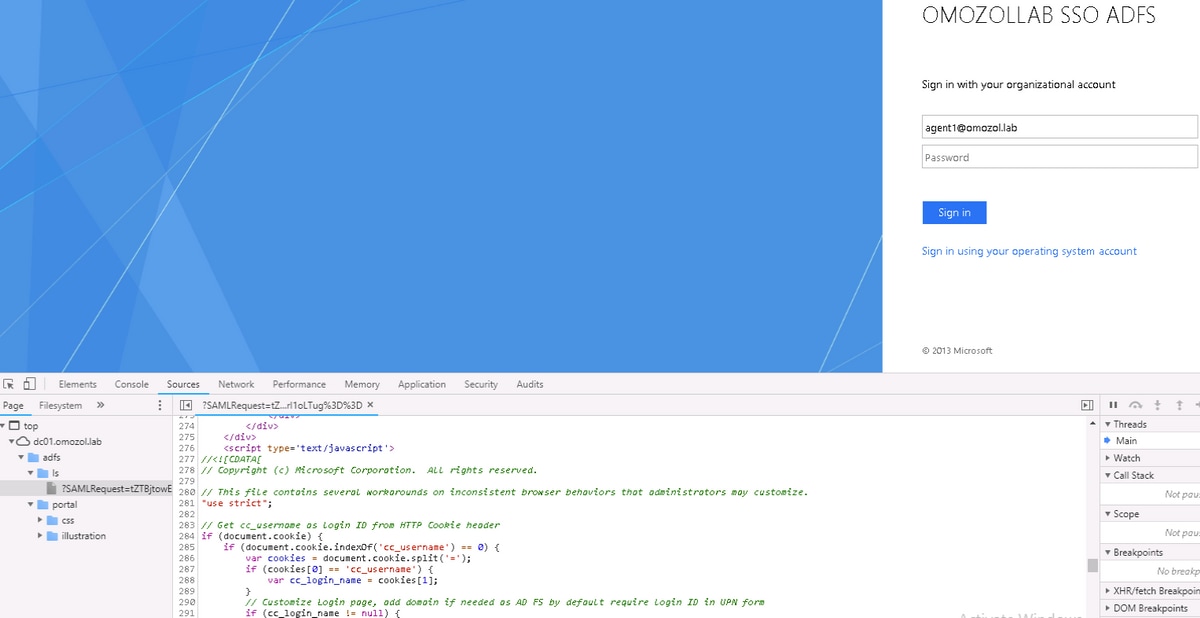在UCCE SSO的AD FS登入頁面上配置自動填充使用者ID
下載選項
無偏見用語
本產品的文件集力求使用無偏見用語。針對本文件集的目的,無偏見係定義為未根據年齡、身心障礙、性別、種族身分、民族身分、性別傾向、社會經濟地位及交織性表示歧視的用語。由於本產品軟體使用者介面中硬式編碼的語言、根據 RFP 文件使用的語言,或引用第三方產品的語言,因此本文件中可能會出現例外狀況。深入瞭解思科如何使用包容性用語。
關於此翻譯
思科已使用電腦和人工技術翻譯本文件,讓全世界的使用者能夠以自己的語言理解支援內容。請注意,即使是最佳機器翻譯,也不如專業譯者翻譯的內容準確。Cisco Systems, Inc. 對這些翻譯的準確度概不負責,並建議一律查看原始英文文件(提供連結)。
簡介
本文說明如何改善統一聯絡中心企業版(UCCE)單一登入(SSO)登入中的終端使用者體驗。 如果不強制使用者在身份提供程式(IdP)登入頁面上再次輸入其登入ID,可以改進此情況。
必要條件
需求
思科建議您瞭解以下主題:
- UCCE SSO登入流和AD FS
- 超文字傳輸通訊協定(HTTP)
- 超文字標籤語言(HTML)
- 安全宣告標籤語言2.0(SAMLv2)
- 開放式授權2.0(OAuthv2)
- 熟悉Windows PowerShell(PS)
- 熟悉JavaScript(JS)
採用元件
本文中的資訊係根據以下軟體和硬體版本:
- UCCE 11.5(1)及更高版本
- Finesse 11.5(1)及更高版本
- Cisco Unified Intelligence Center(CUIC)11.5(1)及更高版本。
- Microsoft Active Directory(AD)- Windows Server上安裝的AD
- AD FS 2.0/3.0
- Windows Server 2012 R2
本文中的資訊是根據特定實驗室環境內的裝置所建立。文中使用到的所有裝置皆從已清除(預設)的組態來啟動。如果您的網路運作中,請確保您瞭解任何指令可能造成的影響。
背景資訊
在UCCE SSO登入中,使用者必須輸入其登入ID兩次:第一次在UCCE應用程式登入頁面(例如Finesse、CUIC)上,第二次在IdP登入頁面(如果使用Forms Authentication方法)。 在本文檔的示例中,Active Directory聯合身份驗證服務(AD FS)用作IdP。
在UCCE中啟用SSO時,在輸入登入ID並在CUIC/Finesse上按下Submit/Login按鈕後,輸入的登入ID將儲存在cookie cc_username中,並保留以供重定向到身份伺服器(IdS),然後重定向到IdP。可以使用IdP登入頁面上的此cookie自動填充登入ID。
供參考,以下是HTTP/SAML流程圖示例,其中終端使用者是Finesse代理,UCCE應用程式是Finesse伺服器。

以下範例顯示終端使用者Web瀏覽器向AD FS(IdP)傳送的步驟4c HTTP要求標頭。
Request URL: https://dc01.omozol.lab/adfs/ls/?SAMLRequest=tZTBjtowEIbv%2BxSR... Accept: text/html,application/xhtml+xml,application/xml;q=0.9,image/webp,image/apng,*/*;q=0.8 Accept-Encoding: gzip, deflate, br Accept-Language: en-US,en;q=0.9 Cache-Control: no-cache Connection: keep-alive Cookie: cc_username=agent1%40omozol.lab Host: dc01.omozol.lab Pragma: no-cache Referer: https://fns01p.omozol.lab/desktop/container/landing.jsp?locale=en_US Upgrade-Insecure-Requests: 1 User-Agent: Mozilla/5.0 (Windows NT 6.3; Win64; x64) AppleWebKit/537.36 (KHTML, like Gecko) Chrome/69.0.3497.100 Safari/537.36
設定
使用AD FS 3.0作為IdP,通過修改onload.js檔案實現配置,AD FS會將該檔案插入返回到使用者的HTML頁面,以響應對https://<AD FS FQDN>/adfs/ls/的請求。
步驟1.若要修改onload.js檔案,請通過PowerShell cmdlet將檔案匯出到檔案系統:
PS C:\> Export-AdfsWebTheme -Name default -DirectoryPath c:\temp\adfs\
onload.js檔案位於以下目錄中:
C:\temp\adfs\script
步驟2.根據登入格式,新增適當的JS代碼片段,使其位於檔案中已經存在的代碼結構/邏輯之外的任何位置。為簡單起見,請將其新增到檔案底部。
預設情況下,AD FS在Windows Server 2012 R2中向SSO使用者顯示的登入頁需要使用者名稱userPrincipleName(UPN)表單。這是類似於電子郵件的格式,例如user@cisco.com。在單個域聯絡中心中,可以修改AD FS登入頁,以允許簡單sAMAccountNameUser ID(UID),該使用者名稱稱中不包含域名。
如果需要在AD FS登入頁面上輸入UPN使用者名稱,請使用此代碼段:
// Get cc_username as login ID from HTTP Cookie header
if (document.cookie) {
// If the position of cc_username in the cookie is the first position, 0...
if (document.cookie.indexOf('cc_username') == 0) {
// Split the cookie into an array with the delimitor being '='
var cookies = document.cookie.split('=');
// If the first element of the array is cc_username then...
if (cookies[0] == 'cc_username') {
// ...the second element will be the actual username and we should save that.
var cc_login_name = cookies[1];
}
// Customize Login page: add domain if needed as AD FS by default require login ID in UPN form
// If the parsed login is not null, do the following logic
if (cc_login_name != null) {
// If %40 (encoded '=') does not exist in the login name...
if (cc_login_name.indexOf('%40') == -1) {
// ...then add '@domain.com' to ensure a UPN format is input
var userNameValue = cc_login_name + '@' + 'domain.com';
// Populate the UPN into the userNameInput of the page, and put the focus
// on the password.
document.getElementById("userNameInput").value = userNameValue;
document.getElementById("passwordInput").focus();
} else {
// Otherwise, if %40 does exist in the username, replace it with the @ sign
// and populate the UPN into the userNameInput of the page, and put the
// focus on the password.
var userNameValue = cc_login_name.replace('%40', '@');
document.getElementById("userNameInput").value = userNameValue;
document.getElementById("passwordInput").focus();
}
}
}
}
在此行中,如果將UPN用作登入UID,則必須修改domain.com以匹配UCCE代理的域。
var userNameValue = cc_login_name + '@' + 'domain.com';
注意:預設情況下,AD FS使用UPN登入。有關如何將AD FS登入頁配置為允許sAMAccountName登入的資訊,請參閱UCCE功能指南、單一登入一章、(可選)在Windows Server 2012 R2中自定義AD FS登入頁部分。
如果在AD FS登入頁上輸入了sAMAccountName(沒有域的UID)使用者名稱,請使用此代碼段:
// Get cc_username as login ID from HTTP Cookie header
if (document.cookie) {
// If the position of cc_username in the cookie is the first position, 0...
if (document.cookie.indexOf('cc_username') == 0) {
// Split the cookie into an array with the delimitor being '='
var cookies = document.cookie.split('=');
// If the first element of the array is cc_username then...
if (cookies[0] == 'cc_username') {
// ...the second element will be the actual username and we should save that.
var cc_login_name = cookies[1];
}
// Customize Login page: remove domain if needed to use login ID in sAMAccount form
// If the parsed login is not null, do the following logic
if (cc_login_name != null) {
// If %40 (encoded '=') DOES exist in the login name...
if (cc_login_name.indexOf('%40') != -1) {
// ...then split the login into an array about the @ sign and only keep the username.
var domainLogin = cc_login_name.replace('%40', '@')
var noDomainLogin = domainLogin.split('@');
var userNameValue = noDomainLogin[0];
// Populate the sAMAccountName into the userNameInput of the page, and put the focus
// on the password.
document.getElementById("userNameInput").value = userNameValue;
document.getElementById("passwordInput").focus();
} else {
// Otherwise, if %40 does not exist in the username, there is no "@domain",
// so populate the sAMAccountName into the userNameInput of the page,
// and put the focus on the password.
document.getElementById("userNameInput").value = cc_login_name;
document.getElementById("passwordInput").focus();
}
}
}
}
註:代碼中的//符號表示註釋。如果需要,可以刪除這些行。其目的是幫助理解Javascript代碼。
步驟3. 儲存onload.js,然後使用以下命令將其重新載入新的AD FS Web主題:
使用預設主題的模板建立自定義AD FS主題:
PS C:\> New-AdfsWebTheme -Name custom -SourceName default
將自定義AD FS主題設定為活動:
PS C:\> Set-AdfsWebConfig -ActiveThemeName custom
將修改的onload.js檔案載入到自定義主題:
PS C:\> Set-AdfsWebTheme -TargetName custom -AdditionalFileResource @{Uri='/adfs/portal/script/onload.js';path="c:\temp\adfs\script\onload.js"}
附註:無需重新啟動AD FS。活動主題將自動修改。
驗證
使用本節內容,確認您的組態是否正常運作。
使用啟用SSO的帳戶(以sAMAccountName或UPN作為登入ID)登入到Finesse或CUIC(取決於AD FS配置),並觀察到,在AD FS登入頁面上,使用者ID會自動填充focus on password prompt欄位。只需輸入密碼即可繼續登入。

疑難排解
本節提供的資訊可用於對組態進行疑難排解。
如果有問題,Web瀏覽器的Developer Tools用於檢查是否將onload.js中的修改插入到返回的HTML頁面,以及是否在Web瀏覽器控制檯中觀察到任何錯誤。
相關資訊
由思科工程師貢獻
- Oleksandr MozolCisco TAC工程師
- Jared CompianoCisco TAC工程師
 意見
意見